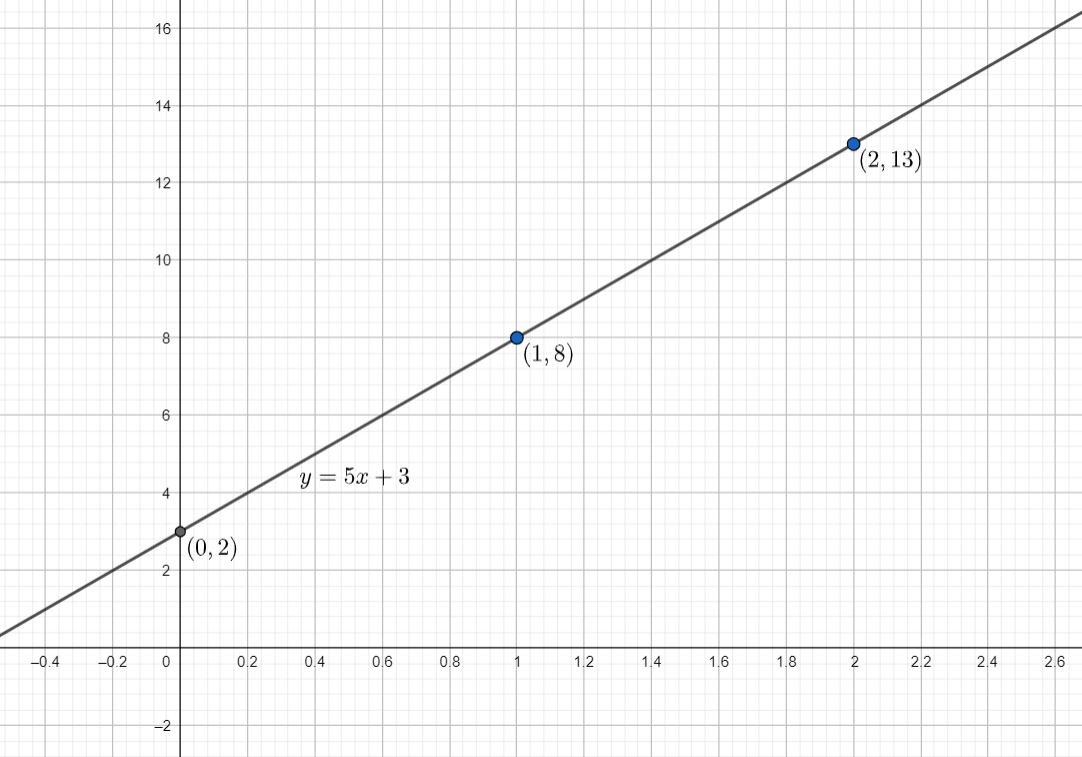
The taxi fare in a city is as follows: for the first kilometer, the fare is $Rs.8$ and for the subsequent distance, it is $Rs.5$ per km. Taking the distance covered as $x$ km and the total fare as $Rs.y$, write a linear equation for this information and draw its graph.
Answer
602.1k+ views
Hint: The given question is related to the formation of linear equations in two variables and the representation of a linear equation on a cartesian plane. Try to form a linear equation in two variables using the information given in the question.
Complete step-by-step answer:
We are given that the fare for the first kilometer is $Rs.8$. Let the total fare for the subsequent distance be $Rs.z$ . We are also given that the total fare for the journey is $Rs.y$ .
So, $y=8+z....(i)$
Now, to find the total fare for subsequent distance, we will use the information that the rate is $Rs.5$ per km.
Now, the total distance is given as $x$ km. So, after the first kilometer, the remaining distance will be $\left( x-1 \right)km$. So, the total fare for subsequent distance will be $Rs.5(x-1)$ . But we assumed it to be $Rs.z$.
So, the value of $z$ is given as $z=5(x-1)$ .
Substituting $z=5(x-1)$ in equation $(i)$ , we get
$y=8+5(x-1)$
$\Rightarrow y=5x+3....(ii)$ which is the required equation.
Now, to draw the graph, we will find any three points lying on the line and join them.
To find the first point, we will substitute $x=1$ in equation $(ii)$ .
On substituting $x=1$ in equation $(ii)$ , we get
$y=5+3=8$
So,$(1,8)$ is the first point.
For the second point, we will substitute $x=0$ in equation $(ii)$ .
On substituting $x=0$ in equation $(ii)$ , we get
$y=0+3=3$
So,$(0,3)$ is the second point.
For the third point, we will substitute $x=2$ in equation $(ii)$ .
On substituting $x=2$ in equation $(ii)$ , we get,
$y=10+3=13$
So,$(2,13)$ is the first point.
So, the graph for the equation $y=5x+3$ is given as :

So, the equation for the given information is given as $y=5x+3$ and the graph is a straight line, passing through the points $(0,3)$ , $(1,8)$ and $(2,13)$ .
Note: While calculating the total fare for subsequent distance, many students make a mistake of taking distance as $x\,km$. For the subsequent journey, the distance will be $(x-1)\,km$ .
Complete step-by-step answer:
We are given that the fare for the first kilometer is $Rs.8$. Let the total fare for the subsequent distance be $Rs.z$ . We are also given that the total fare for the journey is $Rs.y$ .
So, $y=8+z....(i)$
Now, to find the total fare for subsequent distance, we will use the information that the rate is $Rs.5$ per km.
Now, the total distance is given as $x$ km. So, after the first kilometer, the remaining distance will be $\left( x-1 \right)km$. So, the total fare for subsequent distance will be $Rs.5(x-1)$ . But we assumed it to be $Rs.z$.
So, the value of $z$ is given as $z=5(x-1)$ .
Substituting $z=5(x-1)$ in equation $(i)$ , we get
$y=8+5(x-1)$
$\Rightarrow y=5x+3....(ii)$ which is the required equation.
Now, to draw the graph, we will find any three points lying on the line and join them.
To find the first point, we will substitute $x=1$ in equation $(ii)$ .
On substituting $x=1$ in equation $(ii)$ , we get
$y=5+3=8$
So,$(1,8)$ is the first point.
For the second point, we will substitute $x=0$ in equation $(ii)$ .
On substituting $x=0$ in equation $(ii)$ , we get
$y=0+3=3$
So,$(0,3)$ is the second point.
For the third point, we will substitute $x=2$ in equation $(ii)$ .
On substituting $x=2$ in equation $(ii)$ , we get,
$y=10+3=13$
So,$(2,13)$ is the first point.
So, the graph for the equation $y=5x+3$ is given as :

So, the equation for the given information is given as $y=5x+3$ and the graph is a straight line, passing through the points $(0,3)$ , $(1,8)$ and $(2,13)$ .
Note: While calculating the total fare for subsequent distance, many students make a mistake of taking distance as $x\,km$. For the subsequent journey, the distance will be $(x-1)\,km$ .
Recently Updated Pages
In cricket, what is a "pink ball" primarily used for?

In cricket, what is the "new ball" phase?

In cricket, what is a "death over"?

What is the "Powerplay" in T20 cricket?

In cricket, what is a "super over"?

In cricket, what is a "tail-ender"?

Trending doubts
Why is there a time difference of about 5 hours between class 10 social science CBSE

Write a letter to the principal requesting him to grant class 10 english CBSE

Write an application to the principal requesting five class 10 english CBSE

What is the median of the first 10 natural numbers class 10 maths CBSE

The Equation xxx + 2 is Satisfied when x is Equal to Class 10 Maths

Who Won 36 Oscar Awards? Record Holder Revealed




